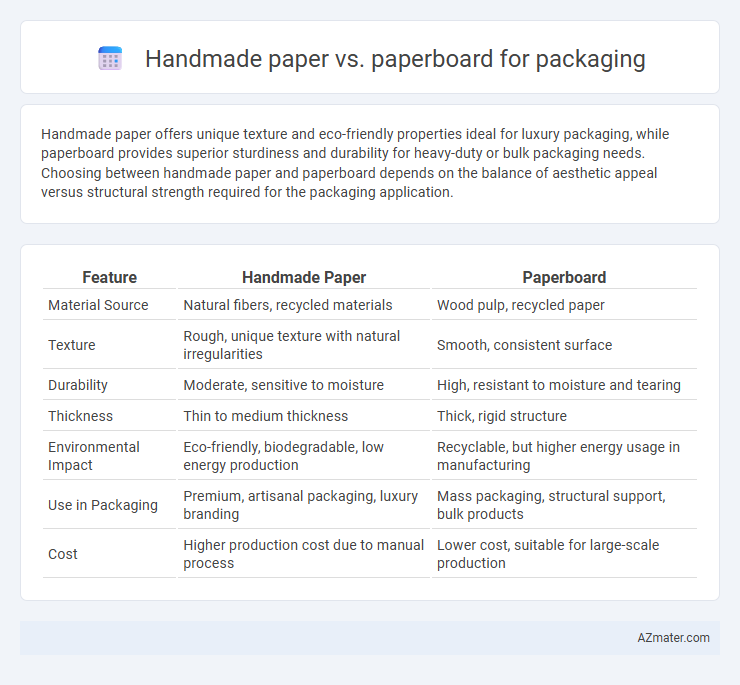Handmade paper offers unique texture and eco-friendly properties ideal for luxury packaging, while paperboard provides superior sturdiness and durability for heavy-duty or bulk packaging needs. Choosing between handmade paper and paperboard depends on the balance of aesthetic appeal versus structural strength required for the packaging application.
Table of Comparison
| Feature | Handmade Paper | Paperboard |
|---|---|---|
| Material Source | Natural fibers, recycled materials | Wood pulp, recycled paper |
| Texture | Rough, unique texture with natural irregularities | Smooth, consistent surface |
| Durability | Moderate, sensitive to moisture | High, resistant to moisture and tearing |
| Thickness | Thin to medium thickness | Thick, rigid structure |
| Environmental Impact | Eco-friendly, biodegradable, low energy production | Recyclable, but higher energy usage in manufacturing |
| Use in Packaging | Premium, artisanal packaging, luxury branding | Mass packaging, structural support, bulk products |
| Cost | Higher production cost due to manual process | Lower cost, suitable for large-scale production |
Introduction to Handmade Paper and Paperboard
Handmade paper is crafted using natural fibers through traditional methods, boasting unique textures and eco-friendly qualities ideal for artisanal packaging. Paperboard, on the other hand, is a thicker, more rigid material made from pulped wood or recycled fibers, offering durability and structural strength for protective packaging solutions. Both materials serve distinct purposes in packaging, with handmade paper emphasizing aesthetics and sustainability, while paperboard ensures robustness and mass production efficiency.
Key Differences in Material Composition
Handmade paper is typically crafted from natural fibers such as cotton, hemp, or recycled textile waste, resulting in a textured, porous material with inherent irregularities. Paperboard, in contrast, is manufactured using wood pulp and often incorporates multiple layers for added strength and rigidity, making it sturdier and more suitable for structural packaging. The organic, fibrous nature of handmade paper lends itself to eco-friendly, artisanal packaging, while paperboard's engineered composition provides durability and protection for heavier or bulkier products.
Sustainability and Environmental Impact
Handmade paper boasts significant sustainability benefits due to its use of natural fibers, minimal chemical processing, and biodegradability, making it an eco-friendly choice for packaging. Paperboard, while widely recycled and versatile in packaging applications, often requires higher energy consumption and chemical treatments during manufacturing, impacting its overall environmental footprint. Choosing handmade paper supports low-impact production methods and reduces waste through compostability, whereas paperboard's recyclability helps minimize landfill contributions but may involve more intensive resource use.
Strength and Durability Comparison
Handmade paper offers unique texture and eco-friendly appeal but generally lacks the strength and durability required for heavy-duty packaging applications. Paperboard, made from compressed layers of paper pulp, provides significantly higher tensile strength and resistance to bending, making it ideal for protecting fragile or heavy items during transit. For packaging solutions demanding robustness and longevity, paperboard outperforms handmade paper by offering superior impact resistance and structural integrity.
Aesthetic Appeal and Customization
Handmade paper offers a unique aesthetic appeal with its textured surface and natural fibers, making it ideal for artisanal and luxury packaging that demands a bespoke look. Paperboard provides smoother, uniform surfaces preferred for vibrant printing and precise branding, supporting extensive customization in shape, thickness, and finish. Both materials enhance packaging design, but handmade paper excels in tactile elegance while paperboard offers versatility in customization and durability.
Cost Analysis and Production Efficiency
Handmade paper generally incurs higher costs due to labor-intensive processes and slower production speeds, making it less economically viable for large-scale packaging compared to paperboard. Paperboard benefits from automated manufacturing and faster production lines, resulting in lower unit costs and improved production efficiency. While handmade paper offers unique aesthetic value, paperboard's cost-effectiveness and scalability dominate in commercial packaging applications.
Applications in Packaging Design
Handmade paper offers unique textures and eco-friendly appeal for luxury and artisanal packaging designs, ideal for boutique products and gift wrapping that emphasize sustainability and craftsmanship. Paperboard provides superior durability and structural integrity, making it suitable for mass-produced packaging such as food boxes, cosmetics, and electronics, where protection and print quality are critical. Both materials serve distinct roles in packaging design, with handmade paper enhancing aesthetic value and paperboard maximizing functionality and scalability.
Printability and Branding Potential
Handmade paper offers unique textures and natural fibers that enhance printability with artisan brands seeking a distinctive, tactile appeal, though it may pose limitations in precision and large-scale color consistency. Paperboard provides a smooth, uniform surface ideal for high-quality, vibrant printing and detailed branding designs, making it suitable for mass production and polished retail packaging. Choosing between handmade paper and paperboard depends on the desired brand image--craft authenticity versus modern, dynamic visual impact.
Consumer Perception and Market Trends
Handmade paper appeals to eco-conscious consumers seeking artisanal, sustainable packaging with unique textures, often perceived as premium and environmentally friendly. Paperboard remains dominant in the packaging market due to its durability, cost-efficiency, and versatility, catering to mass production and mainstream retail demands. Market trends indicate growing interest in handmade paper for niche luxury brands, while paperboard continues to innovate with recyclable and biodegradable options to meet evolving consumer sustainability expectations.
Choosing the Right Material for Packaging Needs
Handmade paper offers a unique texture and eco-friendly appeal, ideal for luxury or artisanal packaging that emphasizes sustainability and aesthetics. Paperboard provides superior durability and structural strength, making it suitable for protecting heavier or more fragile products during shipping and display. Selecting the right material depends on balancing the desired visual impression, protection requirements, and environmental impact of the packaging application.

Infographic: Handmade paper vs Paperboard for Packaging
 azmater.com
azmater.com